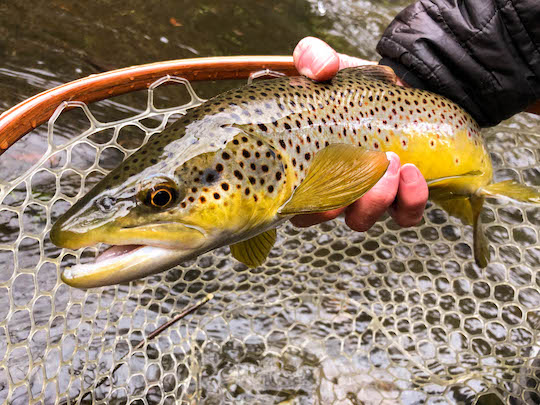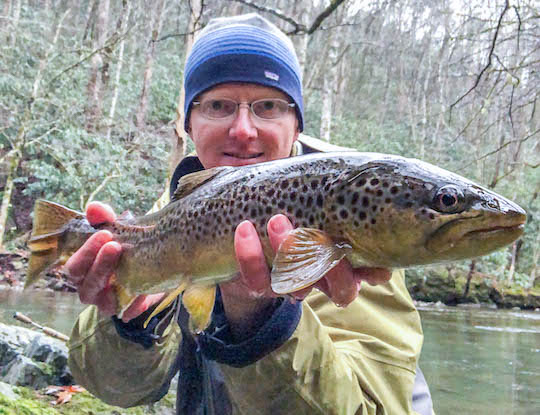Recently, I posted about fishing for post spawn Smoky Mountain brown trout. The first fish of the day was a good one, but as I alluded to in my previous post, this wasn't the end of the day. In fact, it was just the beginning of one of the best days of fishing I've ever had in the Smokies. As you know if you've followed this blog for any length of time, brown trout are right up there with my favorite fish to target, whether its on the fly or otherwise. I also have a real soft spot for brook trout, but in the winter, my thoughts turn to brown trout.
December through February has always been exceptionally kind to me when it comes to brown trout. I've caught my largest brown trout during those months and also had my largest Smoky Mountain brown trout caught in that time frame. The low sun angle means lower light, and I prefer to target cloudy days to further enhance that benefit. Rainy or snowy days are best, but are also an exercise in persistence and perseverance. Fishing in cold rain is not for everyone, and on some days I don't last very long, but the results are hard to argue with.
A few years back, my wife and I took a trip to Yellowstone National Park. Of course, fishing was a part of the trip along with hiking, photography, and general sight seeing. One thing I did in particular was to make time to fish with my friend Bryan Allison to learn some new techniques that would help me become a more well rounded angler and guide. Bryan is an excellent guide covering a variety of waters in Montana and offering some unique trip options that are difficult to find. You can visit his site here.
On our trip, I wanted specifically to work on some trout jigging techniques that he has mastered and are deadly on trout in a variety of waters. Fast forward to now, and you'll find me with a couple of very nice ultralight spinning rods loaded with 4 pound test that rarely if ever see any action. I bought them to be able to offer the option on guided trips, and occasionally mess around with them, but in general I prefer catching fish on a fly rod.
On my recent trip to the Smokies, after catching such a nice brown trout very early in the day on my fly rod, I decided to experiment with the things I had learned from Bryan. My day was already made with that quality brown, so it was time to practice some different techniques. One thing he had taught me was how to use marabou jigs. I figured that was as good of a thing to try as any, so I quickly tied one on and started working it carefully. One huge bonus of using the spinning rod is that you can mostly stay out of the water. That is probably the biggest reason that I try this method more in the winter than at any other time of the year. On really cold days, it keeps me up on the bank, and hopefully away from potential swimming events.
It wouldn't take very long to get things going with the marabou jig. Shortly after nailing my first fish on the fly rod, a golden flash blew up my jig and I was fighting another quality fish. And another, and another, and..........well, you get the idea. The fish were keyed in and ready to chase. Every once in a while the stars align and everything comes together for a great day of catching. Of course, every day is a great day of fishing, but the two aren't always synonymous with each other.
This was really an ideal day to streamer fish, because you want to hit it when the fish are fired up. However, with the falling temperatures and snow starting to fall, I just decided to stick with the trout jigging and stay out of the water as much as possible. The spinning rod was a good way to mostly keep my hands warmer as well. Since I wasn't handling the fly line every cast, I wasn't getting my hands as wet which translated to warmer hands. I still got them plenty wet often enough though. Some quick fish pictures seemed like a good idea to help me remember the epic day that was developing. One other benefit to staying out of the water is that you aren't endangering the redds with their precious cargo of brown trout eggs. Remember to avoid walking in sand and gravel areas in the tailouts of runs and pools. Fish often spawn in these areas and those eggs won't hatch for at least another month most likely.
After that first stop which produced three or four quality brown trout, I moved on up the river. In almost every spot I stopped I found fish. Interestingly, they were all falling into one of three size categories. I've been discussing the lack of truly large fish with my friends lately. Little River seems to be in between big fish cycles. As with most things in nature, numbers of giant brown trout seems to be rather cyclical. Right now, we appear to be on the downside of a cycle. I've seen good numbers of fish up to 18 inches or so, with a few fish pushing on to the 22-23 inch range, but some of the giants of past years don't seem as plentiful. Quite a few of my friends have noticed a similar trend.
On this particular day, I was catching a lot of fish in the 10-17 inch range. The big fish just seemed completely missing in action. When the fishing catching is this good, you normally expect to at least see a few larger trout. I decided to double down and really work some areas that historically hold large brown trout. Yet, it continued to be the same story. Plenty of fish, but no monsters.
I was working up one favorite run and had already caught some fish. In fact, I had some nice browns fighting over my offering at one point. It was just one of those days. Working on up past where I normally see the larger fish, I decided to work on up to the head. This time of year, the fish tend to stay farther back in pools, but it was worth a shot.
As I crept along, I spotted a brown laying on the bottom just upstream. I managed a decent cast and bounced the jig past the fish. Once, twice, three times, it was still as a statue. Suspecting that the fish already knew I was there, I threw one more cast well upstream and began a slow retrieve back past the fish. That was just too much. The fish bolted upstream and out of sight. At no more than a foot long, it wasn't a big fish, but I hate spooking fish ahead of me as they usually alert everything else to my presence. I almost gave up and turned around right there, but something drove me on.
Maneuvering carefully into position, I cast almost straight across. I got one good bounce with the rod tip and something heavy slammed the jig on the drop. Immediately worried about the 4 pound test line, I hoped my knots were good. The drag was set just loose enough while the flex of the ultralight rod absorbed the head shakes. Soon, I slid a gorgeous post spawn female brown into the waiting net. She just about filled up my big Brodin net and pushed the tape to right at 20 inches.
She was lean after the spawn and clearly needed some good meals before winter really set in. I was careful to keep her in the water except for a couple of seconds for a couple of quick pictures. The big net is really handy for these moments. You can rest the fish in the water in between shots, and not risk keeping them out of their element for more than 3-4 seconds at a time. Careful catch and release methods are essential to the preservation of these fisheries as fishing pressure continues to increase every year. If you can't accomplish this, then you should probably avoid fishing for these fish.
The good news about all of these fish is that they can also be caught on a fly rod if you don't want to use a spinning rod. In fact, much of the year, a fly rod is a better tool. However, if you are looking for a way to fish in the winter without getting too wet, then give trout jigging a try. Whether you are fishing in the Smokies or on the Clinch or Caney Fork, this technique works.









